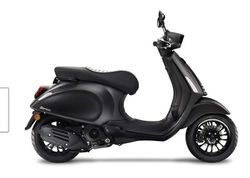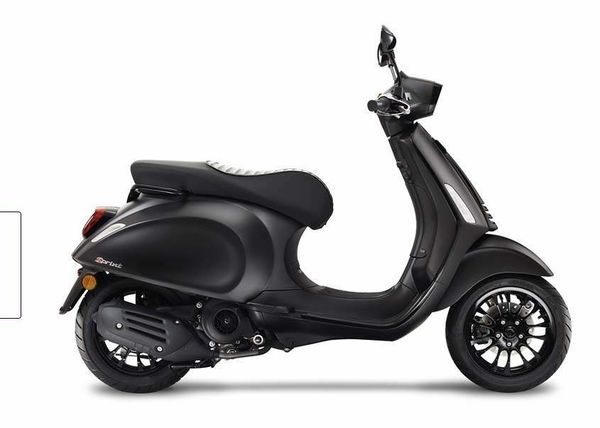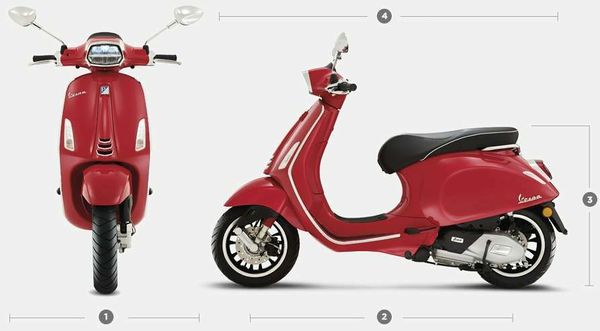Vespa Sprint 150 Notte
 |
|
| Vespa Sprint 150 Notte | |
| Manufacturer | |
|---|---|
| Production | 2018 |
| Engine | Four stroke, single cylinder, SOHC, 3 valve |
| Compression ratio | 10.5:1 |
| Top Speed | 95 km/h / 59 mph |
| Fuel System | Electronic fuel injection |
| Ignition | Electronic |
| Transmission | Auto, twist and go |
| Frame | Sheet metal body with welded reinforcements |
| Suspension | Front: Single arm with coil spring and dual action mono shock absorber Rear: Hydraulic monoshock |
| Brakes | Front: Single stainless steel 220mm disc, hydraulically operated Rear: Drum, 140 mm, mechanically operated |
| Front Tire | 110/70-12 in., tubeless |
| Rear Tire | 20/70-12 in., tubeless |
| Wheelbase | 1340 mm / 52.7 in. |
| Seat Height | 790 mm / 31.1 in. |
| Weight | 117 kg / 258 lbs (dry), |
| Fuel Capacity | 8 Liters / 2.1 US gal |
| Manuals | Service Manual |
It could reach a top speed of 95 km/h / 59 mph.
Engine[edit | edit source]
The engine was a Air cooled, forced cooled Four stroke, single cylinder, SOHC, 3 valve. The engine featured a 10.5:1 compression ratio.
Drive[edit | edit source]
Power was moderated via the Automatic, dry centrifugal with vibration dampers.
Chassis[edit | edit source]
It came with a 110/70-12 in., tubeless front tire and a 20/70-12 in., tubeless rear tire. Stopping was achieved via Single stainless steel 220mm disc, hydraulically operated in the front and a Drum, 140 mm, mechanically operated in the rear. The front suspension was a Single arm with coil spring and dual action mono shock absorber while the rear was equipped with a Hydraulic monoshock. The Sprint 150 Notte was fitted with a 8 Liters / 2.1 US gal fuel tank. The bike weighed just 117 kg / 258 lbs. The wheelbase was 1340 mm / 52.7 in. long.
Photos[edit | edit source]
Overview[edit | edit source]
Vespa Sprint 150 Notte
The all-new Vespa Sprint 150 S débuted at EICMA 2014, enhancing the already extremely
sport spirit thanks to a decisive line and appearance that, even when parked, convey a strong dynamic feel to this Vespa. The livery of the Vespa Sprint 150 S version is simple and appealing, putting emphasis on clean and sober lines while maintaining a minimalist stance with its exclusive Titanium Grey color that, thanks to a small body, brings to mind the most aggressive models of the 70s. In perfect tune with the new tint are the dedicated graphics and the black seat, as are the large 12″ wheel
rims that in black add greater emphasis to its essential elegance. HE HISTORY OF A UNIQUE MODEL Beginning from the mid-sixties following the birth of the Vespa 50, a new generation of Sporty Vespas invaded the European streets. They were small, quick, extremely agile and modern, like the mentality of the young people who rode them. Generations seeking freedom and following the speed of ideas, which in those years were changing the world, found their wings this way. Those little streaks were built on the Vespa 50 body that, from the time it was introduced in 1963, had divided the world of the most popular scooter in the world between Vespino and Vespone, leaving the larger bodied models for the adult riders. A brilliant engine in a smaller and lighter body than the more traditional Vespas: and so in 1966 one of the legendary models from Vespa history was born, the Super Sprint 90, a true special edition derived from the Vespa 50 cc and the new 125. The line left no doubts as to its sport vocation, characterised by the spare tire placed vertically on the footrests and overlapped by a storage compartment between the saddle and the handlebar completed by a padded cushion where the riders chest could rest for leaned over riding like on the competition bikes from that period. The handlebar was narrow and low, revealing the racer aspirations of the SS; the mudguard and cowling were also radically new, streamlined in search of the best aerodynamic efficiency. The silencer, long and chromium, made a bold change to the lines of the past and would influence exhaust shape for the generations to come. With an engine capacity of only 90 cc, it could do 93 kph.
Today it is one of the most popular and sought after models for collectors all over the world and it still leads in historical track races and gymkhanas thanks to its incomparable handling. Later other models would arrive such as the Primavera ET3 in 1976 and the PK 125 in 1983 which solidified the legend of the sporty Vespa. Today the Vespa Sprint is the natural heir to that tradition of vitality, style and youth. It is born out of the body of the recent Vespa Primavera model and, available in 50 and 125 cc versions, it is intended for young people of all ages, enhancing the sporty style that its name, legendary by birth, evokes. THE RETURN OF THE LEGENDARY VESPINO The brand new Sprint is the most sporty and dynamic Vespa small body available. Its name recalls concepts which are intimately tied to the sporty Vespas of the 60s and 70s. The new Vespa Sprint embodies the heritage of the fastest and most youthful Vespas, providing those same essential and indispensable elements that made it so successful with young people such as the sport design saddle and the rectangular headlight, details which the Vespa Sprint shares today. Just as the Vespa Primavera replaced the popular and widespread LX version, the Vespa Sprint replaces the Vespa S (the more sporty version of the Vespa LX), thereby continuing the Vespa tradition of using the same solid, tried and true technical base to create two significantly different models in terms of variation and target rider. Vespa Sprint offers numerous bold aspects which strongly characterise it and set it apart. The saddle has an exclusive design, enhanced by a strictly black covering with a white line finish, a clear tribute to Vespa sport saddles. The convenient fold-away bag hook is still at the end, contributing to increasing the already significant cargo capacity of the Vespa Sprint. In fact, the 16.6 litre helmet compartment can easily accommodate a full jet helmet thanks to the space created by moving the battery into the central tunnel of the footrest. The square-shaped passenger handgrip is also new, which, along with the particular conformation of the footrest, ensures plenty of room for the pillion as well as correct space and a comfortable and safe posture. The hard work of the Piaggio Group Style Centre gave the new Vespa Sprint various exclusive and strongly distinctive stylistic features. The instrument panel, protected by the hint of a spoiler, has a new black background for the speedometer, while the multifunction digital display now has aggressive red backlighting. The same color scheme is applied in the new finish of the neck-tie on the shield. The experience gained in the 946 project, the most prized and technological Vespa of all time, can also be seen in the shape of the new rear-view mirrors, the modern design which integrates perfectly with the overall style of the Vespa Sprint. The headlight has the typical rectangular shape of sporty Vespas. The front daylight running lights are LED, as is the rear brake light. This is a tangible sign of a Vespa that, as always, looks toward the future without forgetting that stylistic tradition which made it a true ambassador of Italian design throughout the world. The most characteristic technical elements on the Vespa Sprint are still its beautiful 12 inch, brand new design aluminum alloy wheel rims. This is the first time that such large diameter wheel rims and large tires are mounted on a Vespa small body, similar to the ones on the GTS series Vespas. This and its other elements contribute to placing the Vespa Sprint between the Primavera and the GTS series, targeting riders who truly want the most from the Vespa small body.
| Make Model | Vespa Sprint 150 Notte |
|---|---|
| Year | 2018 |
| Engine Type | Four stroke, single cylinder, SOHC, 3 valve |
| Displacement | 155 cc / 9.5 cub in. |
| Bore X Stroke | 58 x 58.6 mm |
| Cooling System | Air cooled, forced |
| Compression | 10.5:1 |
| Fuel System | Electronic fuel injection |
| Exhaust | Catalytic converter |
| Ignition | Electronic |
| Starting | Electric |
| Max Power | 9.5 kW / 12.7 hp @ 7750 rpm |
| Max Torque | 12.8 Nm / 1.3 kgf-m / 9.4 lb-ft @ 6500 rpm |
| Clutch | Automatic, dry centrifugal with vibration dampers |
| Transmission | Auto, twist and go |
| Final Drive | Belt |
| Frame | Sheet metal body with welded reinforcements |
| Front Suspension | Single arm with coil spring and dual action mono shock absorber |
| Front Wheel Travel | 78 mm / 3.1 in. |
| Rear Suspension | Hydraulic monoshock |
| Rear Wheel Travel | 70 mm / 2.8 in. |
| Front Brakes | Single stainless steel 220mm disc, hydraulically operated |
| Rear Brakes | Drum, 140 mm, mechanically operated |
| Wheels | Die-cast aluminum alloy |
| Front Rim | 2.50 x 12 in. |
| Rear Rim | 3.00 x 12 in. |
| Front Tire | 110/70-12 in., tubeless |
| Rear Tire | 20/70-12 in., tubeless |
| Dimensions | Length 1860 mm / 73.2 in. Width 735 mm / 28.9 in. |
| Wheelbase | 1340 mm / 52.7 in. |
| Seat Height | 790 mm / 31.1 in. |
| Dry Weight | 117 kg / 258 lbs |
| Fuel Capacity | 8 Liters / 2.1 US gal |
| Average Consumption | 2.0 L/100 km / 49.7 km/l / 117 US mpg |
| Top Speed | 95 km/h / 59 mph |

